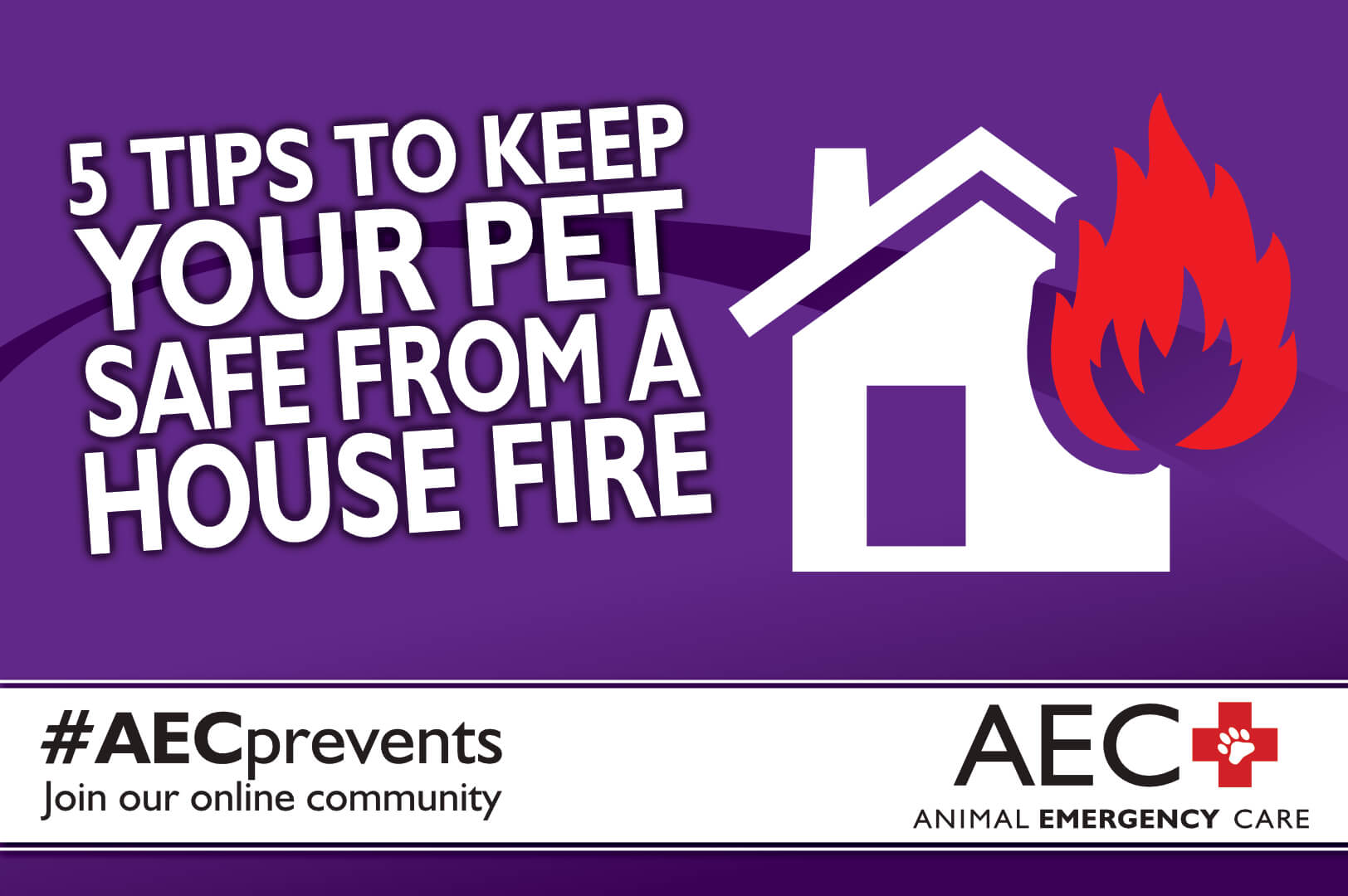Home emergencies like a house fire can strike at a moment’s notice, and taking time to prepare yourself and your pet will decrease stress and ensure a quick and safe response. More than 500,000 pets are affected in residential fires each year and, sadly, more than 40,000 pets die during these events, primarily from smoke inhalation. In response to these frightening statistics, the American Kennel Club, in partnership with ADT Security, created National Pet Fire Safety Day which takes place every year on July 15 to stress the importance of protecting your pets from house fires. Our Animal Emergency Care team wants to ensure pet owners are prepared should an unexpected house fire occur. We have compiled five ways to protect your pet.
#1: Implement fire safety precautions to protect your pet when you aren’t home
Life is slowly returning to normal following the COVID-19 pandemic, and many pet owners are returning to in-person work offices. Therefore, pets may be spending more time at home alone and ensuring safety measures are in place, should an unexpected home fire occur, is critical. Install monitored smoke and carbon monoxide detectors to ensure firefighters are immediately notified of a home fire emergency. Change the batteries at least twice yearly and regularly check that all monitors are functioning properly. Equip your home with several residential fire extinguishers so you can respond quickly if a fire occurs. Regularly inspect your extinguishers and ensure you take appropriate training on proper use and storage. Place a pet alert sticker in a visible location such as a front door or window that includes the number and type of pets and emergency contact numbers, including your family veterinarian.
#2: Pet-proof your home to prevent them from starting a house fire
Investigative paws are a common cause of accidental house fires. Many household items can lead to devastating accidents when pets become curious so pet-proof your home to decrease the chances of a fire. Never leave your pet unattended around any fire source and prevent your pet from accessing the following:
- Candles — Scented candles may be interesting to pets which may lead to burned paws or whiskers, or accidentally knocking a candle over. Consider using battery-operated flameless candles in areas that your pet can easily access.
- Stovetops — Pets accidentally turning on stove knobs are a common cause of pet-generated fires. Consider removing stovetop knobs or using protective covers when not in use.
- Electrical cords — Many pets mistake electrical cords for chew toys which can lead to a dangerous electrical fire and pet injury. Secure all wires and cords and train your pet to stay away from areas where cords are located.
- Fireplaces — Ensure your pet cannot access a lit fireplace by blocking their entrance with a pet gate.
#3: Include your pet in your home evacuation plan
Preparing a home evacuation plan can ease decision-making stress and ensure you are ready to respond at a moment’s notice. Identify all your possible escape routes, practice your evacuation, and gauge how your pet will respond during an emergency. Many pets can sense danger and stress and coercing your pet to safety may be difficult. Ensure you know your pet’s favorite resting, hiding, and sleeping locations. Regularly practice placing your pet in their crate or carrier and use their favorite treat or toy so they associate the crate with a safe, positive space. This will decrease the chances of them running away when you bring out their crate during an emergency evacuation. Place spare leashes near exit areas to be easily accessible during a house fire. Additionally, ensure your home evacuation plan includes:
- Designated family member — Designate one or two family members to gather your pets during a home fire. This will ensure a quick response and help to decrease confusion during an emergency.
- Outside meeting spot — Designate a safe outdoor meeting place for all family members to ensure every person and pet is safe.
- Pet-friendly boarding options — Ensure you have a safe place for your pet if you are not able to return home immediately after a house fire. Many hotels do not allow pets so make a list of pet-friendly shelters, hotels, and boarding facilities near your home.
#4: Assemble a pet emergency kit and learn basic pet first aid and CPR
Assemble a pet emergency kit so you are always prepared for an evacuation that requires an extended time away from your home. Purchase watertight bins or boxes to ensure all supplies stay clean and dry, and include the following in your kit:
- A spare leash, harness, and collar
- A minimum five-day supply of food, water, and medications for each household pet
- Food and water dishes
- Elimination supplies including waste bags, litter, and disposable boxes
- A copy of your pet’s vaccination records and any significant medical history
- Your pet’s microchip number and registration information
- Your pet’s health insurance contact and policy number
- A list of your pet’s medications and dosing instructions
- Name and address of your family veterinarian and Animal Emergency Care
- A current photo of you with your pet, which is helpful to help prove ownership should your pet accidentally run away during a fire evacuation
Consider registering for a pet first aid certification course that includes pet CPR training. Although pet first aid is never a substitute for veterinary care, it allows you to stabilize your pet prior to professional treatment, and may be life-saving.
#5: Financially prepare for your pet’s emergency veterinary care
Pets who are involved in house fires are at risk for smoke inhalation injuries and burns. Bring your pet for a veterinary examination following any exposure to fire or smoke, whether or not they are showing obvious symptoms. Your pet may require hospitalization to receive treatments such as oxygen therapy, intravenous fluids, and pain medications. Emergency care following a house fire can result in a large veterinary bill. However, pet health insurance like Trupanion will ensure you can cover the costs for your pet’s emergency care. Trupanion can pay your veterinary clinic directly which eliminates the need to submit paperwork and wait for reimbursements. Other alternative payment options include:
- Care Credit
- Scratch Pay
- Pet health savings accounts
- Short-term loans
Immediately contact your family veterinarian if your pet has been involved in a house fire, or bring them to Animal Emergency Care if they need help after hours. #AECprevents
Sources:
https://www.aspca.org/news/fire-safety-and-your-pets-keeping-them-safe-unexpected
https://www.avma.org/javma-news/2018-02-15/when-fire-strikes-home
https://www.nfpa.org/-/media/Files/Public-Education/Resources/Safety-tip-sheets/PetSafetyTips.ashx
https://www.aspcapetinsurance.com/resources/5-steps-to-create-a-pet-fire-safety-plan


